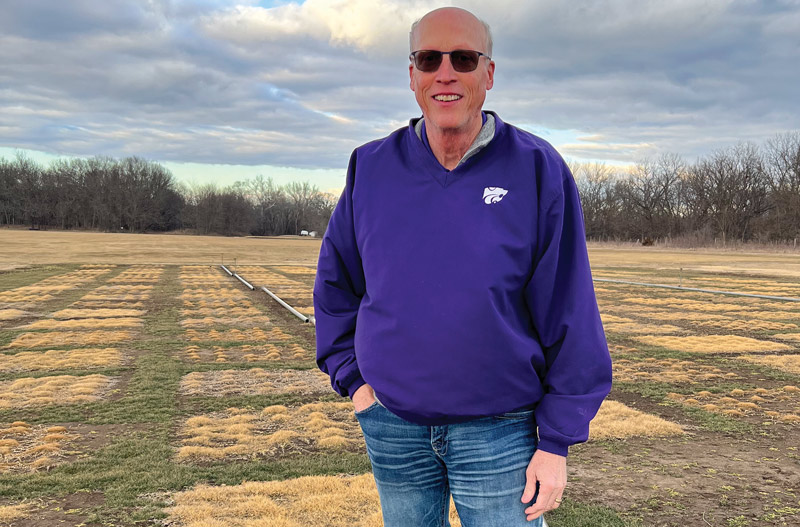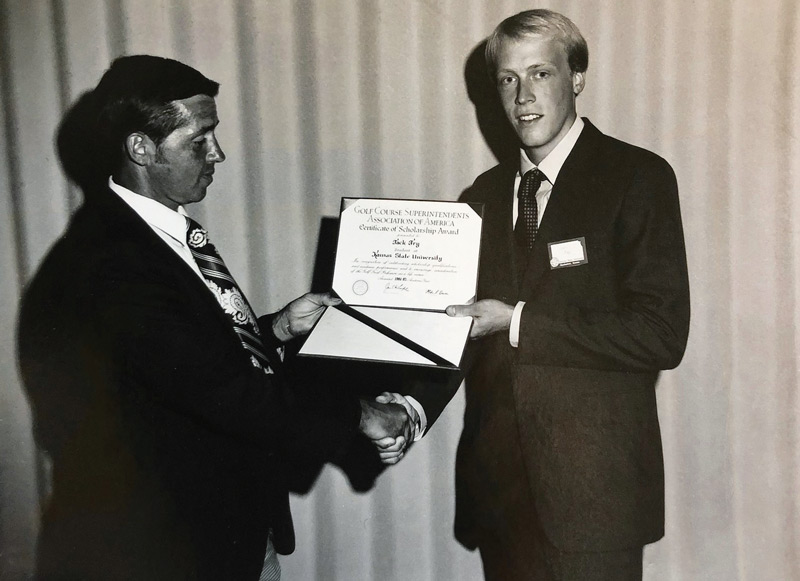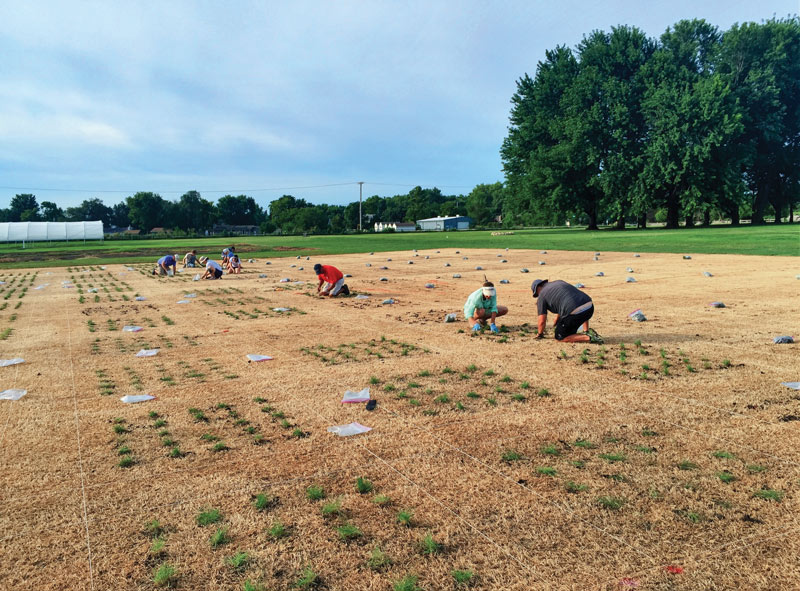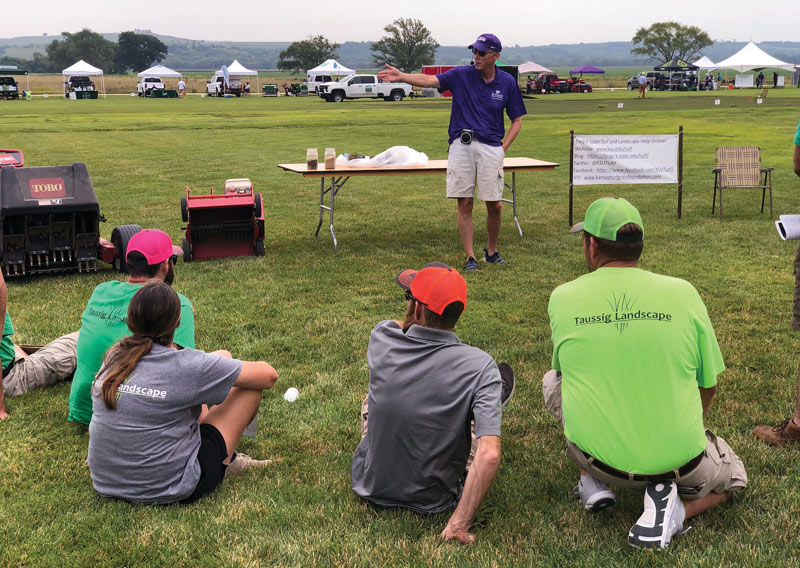
Jack Fry, Ph.D., is currently stationed at Kansas State University’s Horticulture Research and Extension Center in Olathe Kan., where he offers his services in the commercial turf industry. Photo by Roger Billings
High school friends must have wondered why in the world Jack Fry would spend part of his school day at a cross-town rival.
As a student at Shawnee Mission North High School in Overland Park, Kan., Fry regularly drove four miles to Shawnee Mission Northwest High. Simple reason: SM Northwest offered something that SM North did not. “They had horticulture classes,” Fry says.
Those classroom encounters clearly played a vital role in cultivating quite a career. Fry, who holds a doctorate and serves as a professor and commercial turfgrass Extension specialist for Kansas State University, was named the inaugural recipient of GCSAA’s Outstanding Contribution Award. It is designed to recognize an individual who has made a significant contribution to the GCSAA membership through outstanding contributions to the golf course industry. The contribution must be significant in both substance and duration, and it may be or have been regional in nature.
Fry’s past and present work on zoysiagrass breeding is a prime example.
When informed that Fry was being honored, Ambika Chandra, Ph.D., championed it. “I cannot think of anybody better (for the award) than Dr. Fry,” says Chandra, professor in turfgrass breeding genetics in the Department of Soil and Crop Sciences at Texas A&M AgriLife Research in Dallas. “He’s an incredible scientist and plant physiologist. More than that, he’s a visionary and has been able to execute the vision.”
A GCSAA connection
An innocent car ride proved to be inspiration for a curious youth.
Fry remembers driving past Kansas City Country Club in Mission Hills, Kan., looking out the passenger window, intrigued by the well-manicured grass. “I was wondering about the appearance of the putting greens and how you maintain grass at that level, that quality. I would think, ‘How do they do that?’ I think that triggered some of my interest in what I would eventually do,” he says.
He didn’t know it at the time, but Fry would receive a behind-the-scenes look at KCCC not long after he enrolled at K-State in Manhattan in 1978. Fry took classes in turfgrass management from Robert Carrow, Ph.D. During summer break in 1981, Fry secured an internship at KCCC under then-superintendent Bill Spence. In 1982, Fry was presented an undergraduate scholarship by GCSAA, an honor well deserved, according to Carrow. “He was one of the better students that I had. Jack was really sincere, down to earth, knew what he wanted to do, and, on a personal level, a really nice guy, just one of those who is friendly to everybody,” Carrow says. “Certain students you remember. He is one of them.”

In 1982 while at K-State, Fry received GCSAA’s undergraduate scholarship. Photo courtesy of Jack Fry
What Carrow doesn’t remember (because Fry never told him) is the day Fry skipped class and drove to Kansas City, Mo., to watch Boston Celtics basketball star Larry Bird play against the Kansas City Kings. Informed why Fry was absent, Carrow seemed amused and intimated Fry wasn’t the only student who might have missed class at one time or another. “It happens,” Carrow says with a laugh.
A path well traveled and a homecoming
Fry toyed with the idea of becoming an assistant superintendent. He even interviewed for it once. Ultimately, Fry decided to follow the academia path. His journey began in 1982 with legend Peter Dernoeden, Ph.D., at the University of Maryland, where Fry was a graduate assistant in the agronomy department.
Dernoeden doesn’t forget what Fry asked him the first day on campus. “Jack came into my office and stated that he wanted to do a research project that involved zoysiagrass. I was disappointed at first, and then I saw he really meant it. I remember distinctly saying, ‘I know nothing about zoysiagrass.’ Then I said, ‘Let’s do it.’ I was always curious about turfgrasses that were outside the norm,” says Dernoeden, professor emeritus of turfgrass science.
A prolific author and writer (including the column “What’s the Big Idea?” for GCM that sometimes focuses on the Rules of Golf), Fry co-wrote the textbook “Applied Turfgrass Science and Physiology” with Bingru Huang, Ph.D., at Rutgers University. Fry, who got his master’s degree at Maryland, gained extensive knowledge under Dernoeden, who introduced Fry to two legends — zoysiagrass experts Fred Grau, Ph.D., and Jack Murray (in 2011, Fry received the annual Fred V. Grau Turfgrass Science Award). Dernoeden was instrumental in Fry’s rise. “Pete is a very good writer, researcher. He covered pretty much everything,” says Fry.
Next stop for Fry: Colorado State University, where he received his doctorate under the advisement of the late Jack Butler, Ph.D. That’s where he met fellow undergraduate Jim Baird, Ph.D., now turfgrass specialist at University California, Riverside. “He was doing research there about water use on turfgrasses — tedious, very laborious field work, trying to find ways that would help save water,” Baird says. “Jack has done a lot of good, sound and practicable research over the span of his career that is easily understood and practicable by golf course superintendents and turf managers alike. All the while, he never made it about himself. He let the research speak for itself.”
In 1987, Fry moved on to Louisiana State University as an assistant professor. Four years later, home called. Fry was hired in 1991 at K-State as assistant professor in the Department of Horticulture, Forestry and Recreation Resources. For 27 years as director of Rocky Ford Turfgrass Research Center, he showcased a keen eye. Surveying a test plot once, Fry suggested to colleagues to take a closer look at the plots because they might have billbugs in them. He was right. “He’s been there longer than any of us. He has humility. Is humble. He’s been the turf guy at Kansas State,” says Dale Bremer, Ph.D., professor and graduate program director at K-State and 1998 graduate.

Planting experimental zoysiagrasses in March 2015 at K-State. Photo courtesy of Jack Fry
From July 2000-2005, Fry was associate professor (with tenure). A golf course building boom in the 1990s correlates with the turfgrass program’s ascension at K-State. “It was Tiger (Woods) and the impact he had. In concert with that was the interest and start of development at Colbert Hills (golf course in Manhattan). Golf in general was getting a lot of attention,” Fry says. “We went from 40 or so undergrads with interest in turf in the mid-’90s to around 130 undergraduates in the late ’90s and early 2000s.”
GCSAA Class A superintendent Todd Bohn, a 22-year association member, was among the first graduates of K-State’s golf course management program. Now director of agronomy at Desert Mountain in Scottsdale, Ariz., Bohn leaned on Fry’s knowledge of the business, which helped students connect and advance. “Great adviser and coach. Calming influence. Everybody knows Jack Fry for his research work,” Bohn says.
Never-ending pursuit
Turfgrass in the transition zone is better off because of Fry. “Zoysiagrass is a quite popular grass at courses in the transition zone — low input of fertilizers, pesticides and water results in cost savings,” he says.
K-State, in cooperation with Texas A&M AgriLife Research, introduced two new zoysiagrass varieties that were released recently: Chisholm and Innovation. More are on the way. “We’re on the verge of another one or two, maybe more, coming out, and there could be another set in five, 10 years, that we’ve planted and are looking at closely,” says Fry, noting that the USGA is sponsoring the research, and Purdue University is involved as well. “Work with Texas A&M AgriLife Dallas was critical — first with Dr. Milt Engelke and for the past decade-plus with Dr. Chandra. They do the zoysia breeding, and then K-State is able to cooperate with them to evaluate cold-hardiness and performance of the ‘progeny’ (new zoysias that are developed through breeding) in the transition zone.”

Fry addresses participants in a turfgrass field day at K-State in the summer of 2021. Photo by Andrew Hartsock
According to Chandra, the Fry-Engelke union was a game-changer. “Great minds got together,” she says. “He (Fry) is soft spoken, but when he talks, you should listen.” Apparently, his message comes across loud and clear. “His research is always very relevant to the industry, and it answers the questions the industry has. I think he’s the best in the country doing research relevant to the industry,” says Yaling Qian, Ph.D., professor of turfgrass physiology and water relations in plants and soils at Colorado State and Fry’s first graduate student at K-State.
Fry’s consideration of the superintendent resonates with Scott Johnson, CGCS Retired, from Shadow Glen Golf Club in Olathe, Kan. “We offered Shadow as a place to put out some of his prototypes. He had 18 to 20 hybrids and multiple trials. From an economic standpoint and environmental standpoint, he always was trying to find the best,” says Johnson, a 42-year GCSAA member. “He was extremely practical and easy to talk to. He realized he couldn’t solve everything because it cost money. He gave you good solutions that were doable. Jack is a great support system for the super and the property. He helped a lot of people over the years.”
Meyer zoysiagrass was an improved strain evaluated and released (Grau led the release) jointly by the United States Department of Agriculture and USGA in 1951, before Fry was born. In a way, though, zoysiagrass became his baby. “It (Meyer) came out when (Harry) Truman was president,” Bremer says. “It’s been his (Fry’s) lifelong goal to maybe not replace it (Meyer) but bring an alternative to it. He’s had that long game in mind and stayed with it.”
Role shift
Fry has transitioned to his role that combines research and extension for the commercial turf industry at the Horticulture Research and Extension Center in Olathe. His heart, however, still has a soft spot for the K-State faculty and staff two hours west in Manhattan. Fry notes that the team that has so deeply contributed to the success of K-State’s turf program over many years includes Bremer; Christy Dipman; Steve Keeley, Ph.D.; Megan Kennelly, Ph.D.; Larry Leuthold; Ned Tisserat, Ph.D.; and the late Cliff Dipman. “He’s (Fry) kind of been the leader. He has that teamwork personality,” Bremer says. “It’s, ‘Let’s collaborate, help each other out as we go along.’ He wanted to make us succeed. He not only trained scientists; he also appreciates them as people.”
Former K-State student Cole Thompson, Ph.D., who now is USGA director of Green Section research, says, “I’m sure you’ll get other great tidbits about his impact on the industry, so I’ll just reemphasize the number of superintendents he’s touched in formal education, continuing education, and with his research, column and textbook,” says Thompson, who recalls the faculty-versus-grad student match play events in which Fry displayed his skills. “He’s my kryptonite between the ropes, and it haunts me — especially one ridiculously good flop shot that I won’t further acknowledge nor indulge.”
Thompson continued: “He has been so important to the turf industry in Kansas, and his research (and students) reach farther. Resource-use efficiency has been his focus — something that will continue to be important for golf — and he’s touched everything from breeding and physiology to integrated management in his program, often including superintendents and other industry professionals in ideation and execution of research.”
Often, Fry took students on field trips, whether to GCSAA headquarters, golf courses or Arrowhead Stadium, home of the Kansas City Chiefs. “I enjoy being able to help, provide guidance with connections, guidance for their career, and building that relationship and ultimately seeing them be successful when they’re out in the industry,” he says. “If I did a survey for the last five to 10 years of those former students that are supers or involved in other aspects of the industry in the area in Kansas, it is pretty significant. Their doing that and being successful is not only my contribution, but that’s their contribution back to me, too.”

Fry and his wife, Nathalie, on a visit to New York City. This year they will celebrate their 35th wedding anniversary. Photo courtesy of Jack Fry
Former student Tony Goldsby, Ph.D., says, “How do you do justice and describe all the great things about Jack? He wouldn’t hesitate to help in any way. He makes you want to perform better,” says Goldsby, director of turf and specialty products for The Andersons Plant Nutrition Group. “You didn’t want to be the one to let him down.”
Fry is grateful that the university has supported his chosen field of study. “I appreciate K-State’s support of the program. By supporting the program, they’re supporting the industry,” he says.
Not done yet
Fry and his wife, Nathalie, will celebrate their 35th anniversary this year. They have three children and three grandchildren (plus another on the way). Those family ties keep Fry busy. So does his job. Potential accomplishments remain.
“I want to help those in the commercial turf industry through extension as needed, including development of good education events … newsletters, blog posts, field days, conferences, other meetings, etc.,” says Fry, 61, who has participated in seminars at the GCSAA Conference and Trade Show for 24 years. “In research and education, I want to continue to assist graduate and undergraduate students who want to be part of the industry. Continue with selection of high-quality, improved zoysia cultivars that fit in the transition zone. Continue to identify cultivars of all grasses that best fit in Kansas and the Midwest. Continue to evaluate best management practices to improve turf quality on zoysia, tall fescue, bermuda and other grasses in Kansas and the Midwest.”
The GCSAA Outstanding Contribution Award carries special meaning to him. “As you get closer to being done ... it’s important,” Fry, a 25-year GCSAA Education member, says about the honor. “Just getting the respect and attention from those who have been so helpful to me, for so many years, that is nice.”
Howard Richman is GCM’s associate editor.